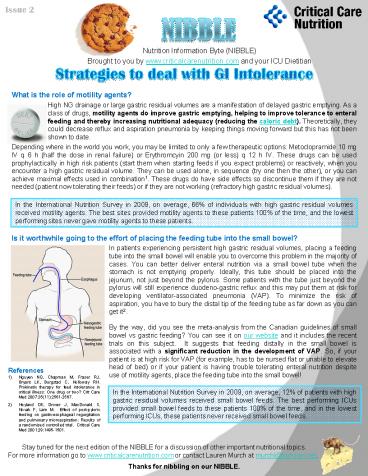Nibble PowerPoint PPT Presentation
Title: Nibble
1
Nibble
Issue 2
- Nutrition Information Byte (NIBBLE)
- Brought to you by www.criticalcarenutrition.com
and your ICU Dietitian
Strategies to deal with GI Intolerance
What is the role of motility agents?
High NG drainage or large gastric residual
volumes are a manifestation of delayed gastric
emptying. As a class of drugs, motility agents do
improve gastric emptying, helping to improve
tolerance to enteral feeding and thereby
increasing nutritional adequacy (reducing the
caloric debt). Theoretically, they could decrease
reflux and aspiration pneumonia by keeping things
moving forward but this has not been shown to
date.
Depending where in the world you work, you may be
limited to only a few therapeutic options
Metoclopramide 10 mg IV q 6 h (half the dose in
renal failure) or Erythromcyin 200 mg (or less) q
12 h IV. These drugs can be used prophylactically
in high risk patients (start them when starting
feeds if you expect problems) or reactively, when
you encounter a high gastric residual volume.
They can be used alone, in sequence (try one then
the other), or you can achieve maximal effects
used in combination1. These drugs do have side
effects so discontinue them if they are not
needed (patient now tolerating their feeds) or if
they are not working (refractory high gastric
residual volumes).
In the International Nutrition Survey in 2009, on
average, 66 of individuals with high gastric
residual volumes received motility agents. The
best sites provided motility agents to these
patients 100 of the time, and the lowest
performing sites never gave motility agents to
these patients.
Is it worthwhile going to the effort of placing
the feeding tube into the small bowel?
In patients experiencing persistent high gastric
residual volumes, placing a feeding tube into the
small bowel will enable you to overcome this
problem in the majority of cases. You can better
deliver enteral nutrition via a small bowel tube
when the stomach is not emptying properly.
Ideally, this tube should be placed into the
jejunum, not just beyond the pylorus. Some
patients with the tube just beyond the pylorus
will still experience duodeno-gastric reflux and
this may put them at risk for developing
ventilator-associated pneumonia (VAP). To
minimize the risk of aspiration, you have to bury
the distal tip of the feeding tube as far down as
you can get it2. By the way, did you see the
meta-analysis from the Canadian guidelines of
small bowel vs gastric feeding? You can see it on
our website and it includes the recent trials on
this subject. It suggests that feeding distally
in the small bowel is associated with a
significant reduction in the development of VAP.
So, if your patient is at high risk for VAP (for
example, has to be nursed flat or unable to
elevate head of bed) or if your patient is having
trouble tolerating enteral nutrition despite use
of motility agents, place the feeding tube into
the small bowel!
- References
- Nguyen NQ, Chapman M, Fraser RJ, Bryant LK,
Burgstad C, Holloway RH. Prokinetic therapy for
feed intolerance in critical illness One drug or
two? Crit Care Med 200735(11)2561-2567. - Heyland DK, Drover J, MacDonald S, Novak F, Lam
M. Effect of post-pyloric feeding on
gastroesophageal regurgitation and pulmonary
microaspiration Results of a randomized
controlled trial. Critical Care Med
2001291495-1501.
In the International Nutrition Survey in 2009, on
average, 12 of patients with high gastric
residual volumes received small bowel feeds. The
best performing ICUs provided small bowel feeds
to these patients 100 of the time, and in the
lowest performing ICUs, these patients never
received small bowel feeds.
Stay tuned for the next edition of the NIBBLE
for a discussion of other important nutritional
topics. For more information go to
www.criticalcarenutrition.com or contact Lauren
Murch at murchl_at_kgh.kari.net.
Thanks for nibbling on our NIBBLE.

